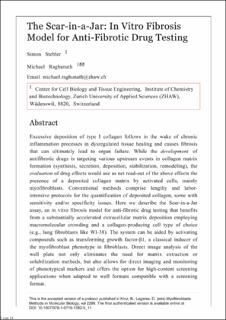Please use this identifier to cite or link to this item:
https://doi.org/10.21256/zhaw-26914| Publication type: | Book part |
| Type of review: | Peer review (publication) |
| Title: | The scar-in-a-jar : in vitro fibrosis model for anti-fibrotic drug testing |
| Authors: | Stebler, Simon Raghunath, Michael |
| et. al: | No |
| DOI: | 10.1007/978-1-0716-1382-5_11 10.21256/zhaw-26914 |
| Published in: | Myofibroblasts |
| Editors of the parent work: | Hinz, Boris Lagares, David |
| Page(s): | 147 |
| Pages to: | 156 |
| Issue Date: | 2021 |
| Series: | Methods in Molecular Biology |
| Series volume: | 2299 |
| Publisher / Ed. Institution: | Humana |
| Publisher / Ed. Institution: | New York |
| ISBN: | 978-1-0716-1382-5 978-1-0716-1381-8 |
| Language: | English |
| Subjects: | Macromolecular crowding; Ultra-flat 3D; Collagen quantitation; Extracellular matrix; Drug discovery; High-content screening; Bioimaging; Immunocytochemistry |
| Subject (DDC): | 610.28: Biomedicine, biomedical engineering |
| Abstract: | Excessive deposition of type I collagen follows in the wake of chronic inflammation processes in dysregulated tissue healing and causes fibrosis that can ultimately lead to organ failure. While the development of antifibrotic drugs is targeting various upstream events in collagen matrix formation (synthesis, secretion, deposition, stabilization, remodeling), the evaluation of drug effects would use as net read-out of the above effects the presence of a deposited collagen matrix by activated cells, mainly myofibroblasts. Conventional methods comprise lengthy and labor-intensive protocols for the quantification of deposited collagen, some with sensitivity and/or specificity issues. Here we describe the Scar-in-a-Jar assay, an in vitro fibrosis model for anti-fibrotic drug testing that benefits from a substantially accelerated extracellular matrix deposition employing macromolecular crowding and a collagen-producing cell type of choice (e.g., lung fibroblasts like WI-38). The system can be aided by activating compounds such as transforming growth factor-β1, a classical inducer of the myofibroblast phenotype in fibroblasts. Direct image analysis of the well plate not only eliminates the need for matrix extraction or solubilization methods, but also allows for direct imaging and monitoring of phenotypical markers and offers the option for high-content screening applications when adapted to well formats compatible with a screening format. |
| URI: | https://digitalcollection.zhaw.ch/handle/11475/26914 |
| Fulltext version: | Accepted version |
| License (according to publishing contract): | Licence according to publishing contract |
| Departement: | Life Sciences and Facility Management |
| Organisational Unit: | Institute of Chemistry and Biotechnology (ICBT) |
| Appears in collections: | Publikationen Life Sciences und Facility Management |
Files in This Item:
| File | Description | Size | Format | |
|---|---|---|---|---|
| 2021_Stebler-Raghunath_Scar-in-a-Jar_Methods_Springer.pdf | Accepted version | 388.37 kB | Adobe PDF |  View/Open |
Show full item record
Stebler, S., & Raghunath, M. (2021). The scar-in-a-jar : in vitro fibrosis model for anti-fibrotic drug testing. In B. Hinz & D. Lagares (Eds.), Myofibroblasts (pp. 147–156). Humana. https://doi.org/10.1007/978-1-0716-1382-5_11
Stebler, S. and Raghunath, M. (2021) ‘The scar-in-a-jar : in vitro fibrosis model for anti-fibrotic drug testing’, in B. Hinz and D. Lagares (eds) Myofibroblasts. New York: Humana, pp. 147–156. Available at: https://doi.org/10.1007/978-1-0716-1382-5_11.
S. Stebler and M. Raghunath, “The scar-in-a-jar : in vitro fibrosis model for anti-fibrotic drug testing,” in Myofibroblasts, B. Hinz and D. Lagares, Eds. New York: Humana, 2021, pp. 147–156. doi: 10.1007/978-1-0716-1382-5_11.
STEBLER, Simon und Michael RAGHUNATH, 2021. The scar-in-a-jar : in vitro fibrosis model for anti-fibrotic drug testing. In: Boris HINZ und David LAGARES (Hrsg.), Myofibroblasts. New York: Humana. S. 147–156. ISBN 978-1-0716-1382-5
Stebler, Simon, and Michael Raghunath. 2021. “The Scar-in-a-Jar : In Vitro Fibrosis Model for Anti-Fibrotic Drug Testing.” In Myofibroblasts, edited by Boris Hinz and David Lagares, 147–56. New York: Humana. https://doi.org/10.1007/978-1-0716-1382-5_11.
Stebler, Simon, and Michael Raghunath. “The Scar-in-a-Jar : In Vitro Fibrosis Model for Anti-Fibrotic Drug Testing.” Myofibroblasts, edited by Boris Hinz and David Lagares, Humana, 2021, pp. 147–56, https://doi.org/10.1007/978-1-0716-1382-5_11.
Items in DSpace are protected by copyright, with all rights reserved, unless otherwise indicated.